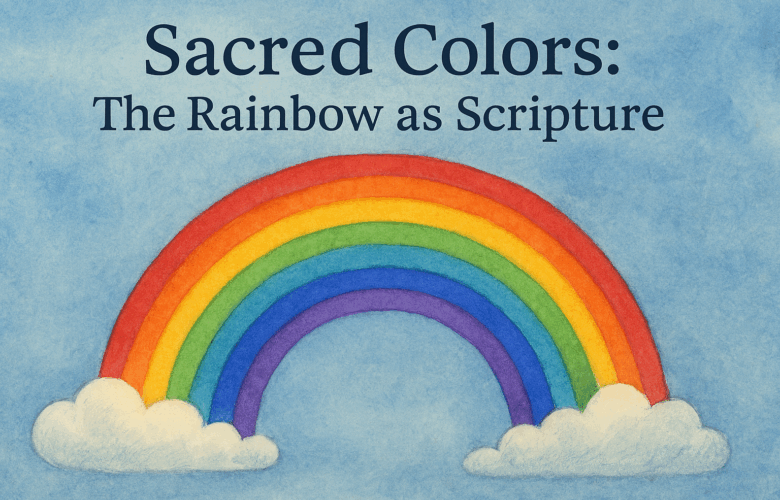Sacred Colors: The Rainbow as Scripture
“A living sacred text written in light and wonder.”
I. The Living Text Above Us
Some scriptures are bound in leather and ink. Others are whispered in silence, carried in breath. And then there are scriptures that stretch across the sky.
The rainbow is one such text—unwritten, untranslated, and older than any scroll or creed. It requires no priesthood to mediate its meaning. No building to house its sanctity. No belief to make it real.
It appears unexpectedly, speaking to the soul in a language we already know. A covenant not imposed by doctrine but offered freely by light and water, by the dance between sun and storm. The rainbow speaks to us—not from above, but from within. It is not a message from a deity to a chosen people, but from nature to all life. It reminds us that beauty is truth, and wonder is holy.
II. Each Color a Verse
The rainbow is not just a symbol. It is a living scripture—one that writes itself new every time it appears. Its verses are color, and its meaning is embodied. It does not argue. It does not demand. It simply is.
Each color is a sacred line in a poem too grand to be spoken aloud:
- Red
The verse of blood and boldness. The pulse of life, the fire in the belly. It is love that protects, rage that resists, and the primal spark that says, I exist. - Orange
The verse of play and pleasure. The warmth between friends, the tang of citrus, the sunset that makes us linger. It reminds us that joy is not frivolous—it is essential. - Yellow
The verse of sunlight and clarity. Laughter on warm pavement, curiosity unbound. It is the light that illuminates the path, and the gleam in a child’s eyes when they learn something new. - Green
The verse of growth and grace. The breath of the forest, the healing of time. It holds space for us to unfurl, to reach toward light while rooted in care. - Blue
The verse of depth and distance. The sky’s invitation, the ocean’s embrace. It is the calm of trust and the ache of longing, all held within a single hue. - Indigo
The verse of mystery. It is twilight, intuition, the knowing that arrives before understanding. A doorway to the unseen. - Violet
The final verse, the sacred return. It is transformation and transience, the sigh at the end of a story. It blesses what was and beckons what could be.
Each time the rainbow appears, it offers this holy sequence anew. And though the order may be the same, the revelation is always fresh—because we are different each time we see it.
III. The Rainbow as Unwritten Scripture
The rainbow cannot be edited, mistranslated, or rewritten. It resists dogma because it does not declare—it reveals. It is ephemeral, yet eternal. Untamed, yet instantly familiar. It shows up in myths, in rituals, on flags and in protests—but it never loses its source.
No one owns it. No one controls it. And though some have tried to steal or sanitize its meaning, the rainbow always remains defiantly inclusive. It blesses everyone who looks up.
When ancient people saw it, they wrote legends to explain it. Today, we may know the science behind it, but that knowledge doesn’t lessen the wonder. In fact, it deepens it.
IV. When Light is Broken, Beauty Emerges
A rainbow exists because light is broken. It meets water, bends, refracts—and in that shattering, the hidden spectrum is revealed.
What a sacred metaphor.
We spend so much time trying to hold ourselves together. But the rainbow whispers: Let yourself break. Let light in. Let it scatter.
In our brokenness, we become beautiful. Not because we are shattered, but because the break reveals our many colors. The complexity within. The sacred spectrum that lives in every soul.
V. Sacred Visibility and Queer Theology
That’s why the rainbow has become a symbol of queer pride—not as a borrowed image, but as a natural theology.
To be queer is to be diverse by nature. It is to live in full spectrum, to defy false binaries, to embody color in a world that prefers black and white.
Pride is not just about identity—it is sacred visibility. It is the holy act of being seen in your fullness.
The rainbow flag is more than a symbol—it is a human-made scripture, inspired by the sky’s own verses. A testimony that we are many-colored, and our wholeness is divine.
VI. The Ephemeral and the Eternal
Rainbows don’t last. You must catch them while they’re there.
And that’s part of their sacredness. They teach us that beauty doesn’t need permanence to be real. That fleeting things—like joy, or breath, or love—can be eternal in impact.
We don’t own a rainbow. We witness it. We remember it. We are changed by it.
It lives in the moment, and then it is gone. Like laughter. Like wonder. Like the best kinds of sacred play.
VII. Sacred Play and the Prism Within
Every one of us is a prism.
We take in the light of the world—its joys, its wounds, its mysteries—and we refract it in our own way. We shine differently depending on where we’re turned, how we’ve been shaped, what light we let through.
To live in sacred play is to honor the colors within you. To let them out, even when the world demands grayscale. To remember that wholeness isn’t found in sameness, but in spectrum.
You don’t have to be the whole rainbow to be holy. Just your hue is enough. Together, we make the sky.
VIII. A Closing Blessing
May your heart be a prism,
your life a rainbow.
May you speak in color,
and may wonder be your only scripture.


